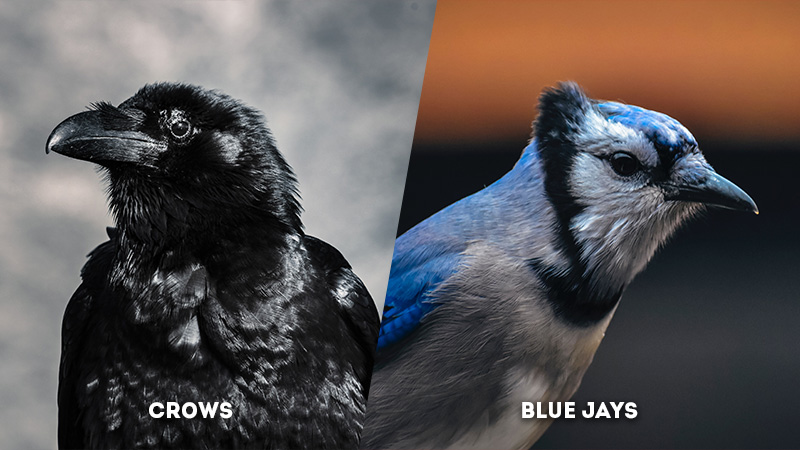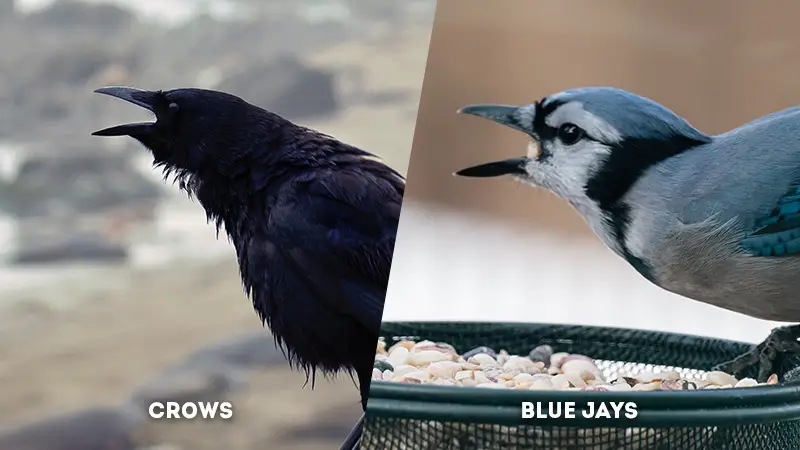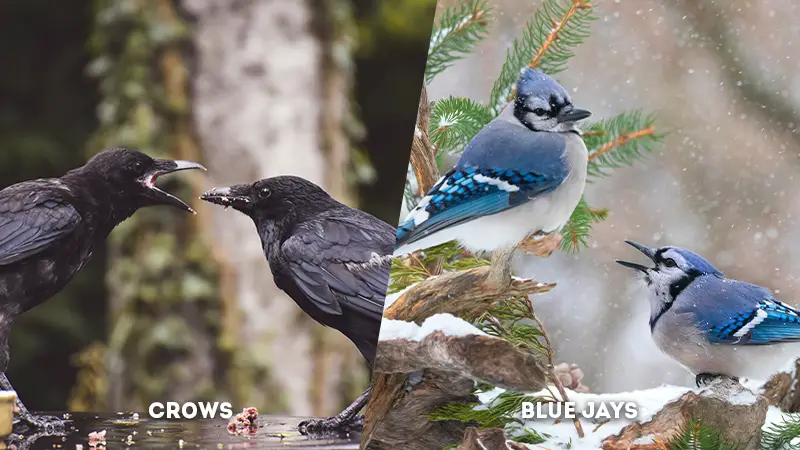Crows and blue jays, members of the Corvidae family, intrigue with their distinctive attributes and behaviors that set them apart within avian diversity.
These birds, while sharing a lineage, exhibit fascinating differences in areas like vocalizations, habitat preferences, cognitive abilities, and ecological roles.
From the remarkable mimicry skills of blue jays to the intelligent problem-solving exhibited by crows, their interactions with their environments and human societies are complex and captivating.
This exploration delves into these distinctions, offering insights into how these birds navigate their world and contribute to the intricate tapestry of nature.

Key Differences Between Crows and Blue Jays
Here are some key differences between crows and blue jays
Size
- Crows: Crows are generally larger birds within the Corvidae family, characterized by their stout bodies and strong bills. Their size can vary depending on the specific species and location, but they commonly possess a robust physical presence.
- Blue Jays: In contrast, blue jays are slightly smaller and exhibit a sleeker build. Their bodies are not as stocky as crows, giving them a more streamlined appearance.
Coloration
- Crows: Crows are primarily known for their all-black feathers. This dark coloration serves as effective camouflage and protection, allowing them to blend into their surroundings and potentially avoid predators.
- Blue Jays: Blue jays, as their name suggests, are distinguished by their vivid blue plumage, with white and black markings. This striking coloration serves both aesthetic and communicative purposes, making them easily recognizable in their habitats.
Head Crest

- Crows: Crows lack the prominent head crest that is often seen in other Corvidae species. Their heads are relatively smooth and lack any distinctive crests or tufts.
- Blue Jays: One of the most noticeable features of blue jays is their prominent head crest. This crest can be raised or lowered, depending on the bird’s mood or level of excitement. It adds to their visual appeal and uniqueness.
Intelligence
- Crows: Crows are renowned for their exceptional intelligence and problem-solving abilities. Studies have shown that they can use tools to accomplish tasks, remember human faces, and exhibit complex social behaviors. Their cognitive abilities rival those of some primates.
- Blue Jays: While blue jays are also considered intelligent birds, they may not reach the same level of problem-solving ability as crows. Their intelligence is often demonstrated through their mimicry skills, where they can imitate the calls of other birds and even some human-made noises.
Tool Use
- Crows: Crows have gained fame for their remarkable tool-using behaviors. They have been observed using sticks, leaves, and other objects as tools to extract food from hard-to-reach places. This capacity for tool use showcases their adaptability and resourcefulness.
- Blue Jays: Blue jays exhibit tool use to a lesser extent compared to crows. While they may not display the same level of complexity in tool manipulation, they still exhibit resourceful behaviors in their natural environments.
Vocalizations

- Crows: Crows are known for their distinct cawing calls, characterized by a rough and hoarse sound. These calls serve a variety of functions, from communication within their group to alerting others about potential dangers.
The range of cawing tones and pitches allows crows to convey different messages and information to one another. - Blue Jays: Blue jays, in contrast, possess a diverse vocal repertoire. Their most recognizable call, the “jay” call, is a loud and piercing sound that serves as a form of communication within their social groups.
However, what sets blue jays apart is their exceptional mimicry skills. They can imitate the calls of other birds, animals, and even mechanical sounds, showcasing their ability to adapt their vocalizations to various contexts.
Social Behavior
- Crows: Crows are highly social birds, often forming tight-knit family groups. They exhibit complex social behaviors, including cooperative hunting and communal roosting.
Additionally, crows are known for their potential to remember human faces, allowing them to recognize individual humans and potentially alter their behavior based on prior interactions. - Blue Jays: Blue jays also exhibit social behavior, but their interactions tend to revolve around territoriality and defense.
They are known for being territorial birds that aggressively defend their feeding and nesting areas from intruders, including other blue jays. This territorial behavior can lead to loud confrontations and displays of dominance.
Habitat Adaptability
- Crows: Crows are highly adaptable and can thrive in a wide range of habitats, from forests and open fields to urban environments. This adaptability has contributed to their success in various ecosystems, making them a common sight in both rural and urban areas.
- Blue Jays: While blue jays are also adaptable, they exhibit preferences for specific habitats, such as woodlands and forests.
They are often found in areas with abundant trees and foliage, where they can build their nests and find food sources like acorns and insects. This preference for wooded environments limits their presence in more urbanized landscapes.
Urban Presence
- Crows: Crows have a notable presence in urban areas, thanks to their adaptability and resourcefulness. They have shown the ability to exploit human-made environments, scavenging for food scraps and nesting in urban structures.
Their intelligence allows them to find creative ways to navigate and benefit from urban landscapes. - Blue Jays: Blue jays are less commonly found in heavily urbanized areas. While they might visit suburban neighborhoods with trees, they generally prefer areas with more natural vegetation. Their territorial behavior and reliance on specific food sources like acorns might limit their ability to thrive in urban settings.
Territorial Behavior
- Crows: Crows exhibit territorial behavior to a certain extent, but their social dynamics are more complex than just defending a territory. They form family groups and larger gatherings at communal roosts, which can consist of multiple families.
This cooperative behavior suggests that while crows defend their immediate territories, they also engage in communal activities. - Blue Jays: Blue jays are known for their strong territorial behavior. They defend their territories fiercely, especially during the breeding season. Confrontations between neighboring blue jays are not uncommon, and these conflicts can involve vocalizations and aggressive displays.
Range
- Crows: Crows are highly adaptable birds found across a wide range of habitats globally. Their distribution spans continents, including North America, Europe, Asia, and Africa. This adaptability to various environments contributes to their widespread presence in both natural and urban landscapes.
- Blue Jays: Blue jays, while also adaptable, have a more limited range predominantly within North America. They are commonly found in woodlands, forests, and suburban areas throughout the United States and parts of Canada. Their localized distribution highlights their specialization for specific habitats.
Feeding Habits

- Crows: Crows are omnivores with diverse feeding habits. They scavenge for a wide range of food items, including carrion, insects, small animals, fruits, and human food scraps. This adaptability in diet allows them to exploit various food sources in their habitats.
- Blue Jays: Blue jays are known for their penchant for acorns. They feed on a diet that includes seeds, nuts, insects, and occasionally small vertebrates. Their preference for acorns contributes to their role as seed dispersers in forest ecosystems, aiding in the regeneration of plant species.
Flight Pattern
- Crows: Crows exhibit steady and deliberate flight patterns. Their flight is characterized by strong and deliberate wingbeats, allowing them to cover relatively long distances while maintaining control and stability.
- Blue Jays: Blue jays display a more agile and acrobatic flight pattern. They are capable of quick maneuvers, often seen darting through trees and vegetation. Their flight style is well-suited for navigating wooded environments and evading predators.
Nesting
- Crows: Crows build well-constructed nests usually high in trees, utilizing a combination of twigs, branches, and other materials. These nests provide protection for their eggs and young, and they often exhibit a complex architectural design.
- Blue Jays: Blue jays also build nests in trees, but their nests are typically less elaborate compared to those of crows. They construct nests using twigs, leaves, and grasses, creating a cup-shaped structure for incubating eggs and raising their young.
Mating System
- Crows: Crows generally have a monogamous mating system, with pairs forming long-term bonds. They work together to build nests, incubate eggs, and raise offspring. In some cases, young crows may remain with their parents for several years to assist in raising subsequent broods.
- Blue Jays: Blue jays also exhibit a monogamous mating system. Pairs form during the breeding season and cooperate in raising their young. Occasionally, blue jays may form temporary groupings, but monogamous pairs are the norm.
Mimicry Skills
- Crows: Crows are known for their cognitive abilities and problem-solving skills rather than vocal mimicry. While they might mimic some sounds to communicate with their own kind, their primary focus lies in using tools and learning complex behaviors.
- Blue Jays: Blue jays, on the other hand, are renowned for their exceptional mimicry skills. They can replicate the calls of other bird species, animals, and even mechanical noises. This adaptability in mimicry broadens their communication abilities and enhances their survival strategies.
Voice Variety
- Crows: Crows exhibit a more limited vocal range, often characterized by their distinct cawing calls. These calls can vary in pitch and tone, but they generally serve communication and alarm purposes within their social groups.
- Blue Jays: Blue jays are recognized for their rich voice variety. Alongside their iconic “jay” call, they can imitate the sounds of other birds, animals, and even human-made noises. This diversity of vocalizations allows them to communicate effectively in different situations.
Conservation Status
- Crows: The conservation status of crow species varies. While some populations of crows are thriving and considered of least concern, others might be threatened due to habitat loss, urbanization, and other human-related factors. Their adaptability to urban environments has, in some cases, helped mitigate population declines.
- Blue Jays: Blue jays are generally considered of least concern in terms of conservation status. However, local declines can occur due to factors such as habitat destruction and nest predation. Their specialized diet and reliance on specific habitats might make them vulnerable to changes in their environments.
Human Interaction
- Crows: Crows’ interactions with humans are marked by their ability to recognize and remember individual faces. They can distinguish between friendly and hostile humans and adjust their behavior accordingly.
This interaction has sparked research into animal cognition and the ways in which birds perceive and respond to human presence. - Blue Jays: Blue jays’ interactions with humans are often centered around their vibrant appearances, mimicry skills, and vocalizations. Their mimicry of human sounds has led to their portrayal in stories, folklore, and cultural narratives.
Population Dynamics
- Crows: Crow populations can vary widely depending on the species and geographical region. Some crow species have adapted well to urbanization, resulting in stable or even increasing populations. However, the impact of human activities can still influence their numbers.
- Blue Jays: Blue jay populations also vary across their range. Their localized distribution and specialization for specific habitats might lead to population fluctuations in response to environmental changes.
Crows Vs Blue Jays: Comparison Table
| Aspect | Crows | Blue Jays |
|---|---|---|
| Size | Larger, stout bodies | Slightly smaller, sleeker build |
| Coloration | All-black feathers | Blue, white, and black markings |
| Head Crest | Absent | Prominent crest on the head |
| Intelligence | Highly intelligent, problem solvers | Intelligent, mimicry skills |
| Tool Use | Known to use tools for tasks | Less frequent tool use |
| Vocalizations | Distinct cawing calls | “Jay” call, mimicry of sounds |
| Social Behavior | Complex social interactions | Territorial and aggressive |
| Habitat Adaptability | Thrives in various environments | Prefers woodlands and forests |
| Urban Presence | Common in urban areas | Less common in heavily urbanized |
| Territorial Behavior | Moderate territorial tendencies | Strong territorial behavior |
| Range | Wide distribution globally | Predominantly North America |
| Feeding Habits | Omnivorous, scavengers | Omnivorous, acorn hoarding |
| Flight Pattern | Steady, deliberate flight | More agile and acrobatic |
| Nesting | High in trees, well-constructed nests | Nests in trees, less elaborate |
| Mating System | Generally monogamous | Monogamous with occasional duos |
| Mimicry Skills | Limited mimicking abilities | Excellent mimicry repertoire |
| Voice Variety | Less diverse vocal range | Wide range of calls and sounds |
| Conservation Status | Varies by species, some are threatened | Least Concern, no major threats |
| Human Interaction | May recognize and remember faces | Generally less recognition of faces |
| Population | Diverse species and populations | Fewer species and smaller range |
Frequently Asked Questions
Crows aid in nutrient cycling by scavenging carrion and organic matter, preventing potential disease spread. Blue jays play a crucial role in forest regeneration by dispersing seeds, particularly acorns, which results in the growth of new plants and trees.
Yes, but their responses differ. Crows adapt well to urban environments due to their intelligence and versatility, often thriving in city settings. Blue jays, however, are less commonly found in heavily urbanized areas due to their preference for wooded habitats and specialized diet.
Crows’ ability to recognize individual human faces has sparked scientific research on animal cognition. Blue jays capture human interest with their vocal mimicry skills, which often lead to cultural depictions in stories and folklore.
No, blue jays are vocal and versatile communicators. While their “jay” call is prominent, they possess exceptional mimicry skills, imitating the sounds of other birds, animals, and even mechanical noises to convey various messages.
Crows’ conservation status varies by species and region due to habitat loss and urbanization. Efforts may include protecting their nesting sites and addressing human-wildlife conflicts. Blue jays are generally of least concern, but local declines can prompt habitat protection and management to ensure their specialized needs are met.
To Recap
The dynamic contrasts between crows and blue jays underscore the astonishing diversity within the avian world. Their distinct vocalizations, social behaviors, habitat preferences, and more reflect their adaptability to various ecosystems.
As these birds interact with their environments and human interactions, they carve out unique roles that contribute to ecological balance and cultural symbolism.
Through their mimicry, intelligence, and interactions, crows and blue jays remind us of the intricate interplay between species, fostering a deeper appreciation for the complex connections that define the natural world.